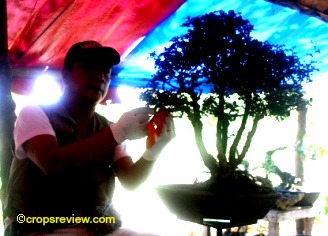A bonsai tree is an artistic replica of a natural tree in miniature form.
It exists in a pot or container which is either naturally or artificially made.
It may also be growing out of a crevice of or clasping a rock or stone, or clinging to its side.
Above all, it should portray an illusion of a natural scene or the active interplay of the elements of nature.
The actual age of the tree or trees is not so important, it is the illusion of age that matters.
There are, therefore, four essential requisites of a bonsai tree, namely:
(1) there is a dwarf tree or trees which appear to be a miniaturized reproduction of a real and old tree or trees;
(2) such tree or trees are growing in a pot or container or attached to some rock or other support;
(3) the trees are aesthetically appealing either singly or as an overall effect in grouping trees;
and (4) the ultimate effect is that the presentation reminds the viewer of natural scenery.
Yes, having a dwarf tree is not enough. Not even if it is potted in a beautiful container.
Without the other requisites, such a tree will just be a dwarf tree or miniature or a potted tree.
The Bonsai Tree Must Be Artistically Appealing, Possessing the Elements of Visual Art
Composition, line, form, depth, proportion, balance, etc. must be visible.
The tree must have a front and back.
As in painting and sculpture, the portrayal of being three-dimensional, real, and live must be intriguingly convincing.
As in painting and sculpture, the artistic creation must elicit that feeling of wanting to touch it to eliminate any further doubt that indeed the tree is real or otherwise merely illusionary.

Kyuzo Murata, one of the most respected and loved Japanese masters and who for many years used to be the curator of the bonsai collection of the Emperor of Japan shed light on the definition of bonsai in an essay (Giorgi G. 1990. Simon and Schuster’s Guide to Bonsai. New York, NY: Fireside. 255 p.). Accordingly,
Bonsai is a living plant transferred to a pot or tray or a rock or stone so that it can continue to live semi-permanently. It has not only the natural beauty of the particular plant but the appearance reminds people of something other than the plant itself. It could be a scene, a forest or part of a forest, a lone tree in the field, a seascape, a lake, a river or a stream, or a pond. It is also possible that a certain appearance reminds a person of the wind blowing through the branches.
He further added: In Japan, the meaning of bonsai is to create a natural scene on the tray, using plants as the main materials. When you take a Hachiuye or potted plant, you can only see the “prettiness of the plant or flower.” It does not remind you of anything else.
The Bonsai Tree Should Not Only Be Aesthetically Pleasing
Indeed, the bonsai tree should not only be aesthetically pleasing but the overall presentation should remind the viewer of the active participation of the elements of nature.
In contrast, a mere potted plant is appreciated only for its attractive leaves, flowers, or fruits; a topiary for its well-scissored overall shape.
Thus a single upright bonsai with green, healthy moss as groundcover imitates a lone tree in the middle of grassland or prairie viewed from a distance, where climatic conditions favor vigorous growth.
A slanting style depicts a tree that is about to topple down yet remains proudly rooted to the ground despite the erosive effects of water or the buffeting of strong wind.
A cascade hangs from the face of a cliff or looks down from the bank of a river.
A strong wind blows to either the left or right of the viewer most of the branches of a windswept.
Driftwood remains defiant, surviving against the ravages of time, drought, and stressful conditions.
The list of bonsai tree styles and the natural scenery that they intend to portray are quite numerous.
I What is Bonsai? I Bonsai Rules I Pruning Rules Applied I Molave Bonsai I
